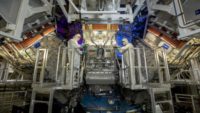NET Power Inc., which is building in Texas what it says is the first utility-scale gas-fired power plant with near zero carbon emissions, has added at least one year to the 370-MW facility’s anticipated completion. Firm executives cited “extensive lead times across critical components” in reporting the energy startup's third-quarter results on Nov. 14.
Firm President and COO Brian Allen told investors and analysts that anticipated startup of the plant, under construction in the state’s Permian oil and gas region, has slipped to “sometime between the second half of 2027 and first half of 2028.” Its cost also now is stated as $1 billion, up from $750 to $950 million, when work began in 2022.
The project in Odessa is set to remove 860,000 tons of carbon dioxide per year, which will be captured using NET Power's proprietary process and stored underground nearby.
The company’s oxy-combustion supercritical carbon dioxide power cycle was successfully proven at its demonstration plant in La Porte, Texas—a 50-MW pilot completed by contractor McDermott International in 2021 and successfully synchronized with the Texas grid after operating for more than 1,500 hours.
"Our first plant will ultimately set the stage for future deployment, and it's of the utmost important to get our first one right," NETPower CEO Danny Rice said on the call. "We're taking a methodical approach to ensure that this first utility-scale project validates the technology while operating with a focus on clean, reliable, and safe operations."
Component Long Waits
But he and other firm executives cited supply chain disruptions and delays in key components for the announced year delay.
Long lead times for distribution transformers and other components have emerged in recent months as a bottleneck in meeting climate goals and upgrading the U.S. power grid, industry leaders and energy officials have noted.
"It's really just a general issue facing the energy industry right now as we come out of the post pandemic period," said Allen, noting current long delays for transformers, "what I would have viewed in the past as a commodity item."
He said that in the Odessa project's pre-FEED schedule several years ago, lead time for the plant's main transformer was anticipated as one year. "That's looking more like three years now," he said, "This is a general trend in the whole supply chain, we just wanted to update that reality into our schedule."
Front-end engineering and design is expected to be completed on the 370-MW, $1 billion plant Permian Basin project in 2024 by EPC contractor Zachry Group and will be the basis for the company’s standardized utility-scale plants.
NET Power’s standard modularized utility-scale design is expected to rapidly drive down capital costs for subsequent plants, Rice said, adding that he expects the supply chain bottleneck to be resolved by the time it deploys a second utility scale plant. For that project, NET Power finished a technical feasibility study and plans to submit permits for grid interconnection and carbon sequestration in 2024 that it began working on earlier this year, Rice said.
NET Power completed initial survey and environmental assessment of the current plant site during the third quarter and released initial bid packages for long-lead equipment with orders to be made in the first half of 2024.
DOE Funding Sought
The La Porte facility is undergoing modifications to improve combustor and turboexpander demonstrations with Baker Hughes, a project partner along with Occidental Oil and other investors. “These efforts are critical to de-risking Project Permian and refining NET Power's plant controls architecture,” Nte company said.
Occidental, an early investor in the start-up company, increased its investment in April to a 39% stake. Other NET Power partners include Constellation Energy, 8 Rivers Capital and Baker Hughes, which is developing supercritical CO2 turboexpanders and other pumping and compression technology needed for NET Power’s plants,
Rice Acquisitions, a special purpose acquisition company, entered into a joint development agreement wih NET Power last December to accelerate project deployment, investing $100 million. The startup became a publicly traded company in June on the New York Stock Exchange valued at $1.46 billion.
NET Power's financial outlook remains strong due to its significant cash reserves and over-capitalization upon going public, said its CFO Akash Patel. The firm ended the third quarter "with a strong balance sheet, including approximately $645 million of cash and short-term investments," he said. "We have sufficient capital through Project Permian commissioning. Our overcapitalized balance sheet provides us with a unique competitive advantage."
Allen added that the firm, in the second quarter, submitted a grant application for up to $270 million to the US Energy Dept. Office of Clean Energy Demonstrations, with a decision expected in Q4.
"One thing that's so important is really making sure we're very judicious and prudent about being very transparent about all the details of these projects only when the project is fully baked," said Rice. "That means ... we have alignment with local landowners, communities, regulatory agencies, both within the state and at the federal level, and local utilities."
He added, "The CCUS industry specifically ... seen what happens if you announce projects before they're fully baked."
Rice’s goal is to license 30 plants per year by 2030.







Post a comment to this article
Report Abusive Comment